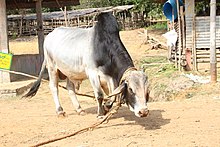Tharparkar beef
The Tharparkar cattle ( Urdu : تھرپارکر) a Zebu breed of animals from the district of Tharparkar in the province of Sindh in Pakistan .
origin
The Tharparkar is a zebra breed that is used for milk production and as a draft animal. He is one of the zebra breeds that have lyre-shaped horns. The Tharparkar became known worldwide during World War I when some animals were used as milk suppliers for the army camps in the Middle East. It was then that their ability to produce milk under adverse feeding and environmental conditions became evident. Since then, many breeding herds have been established in India and Pakistan . In arid areas, their milk production is almost 1,135 kg per lactation, while the cows in the villages even produce 1,980 kg.
In India and the surrounding regions, these cattle are known as "Tharparkar" because they come from this district in Sindh Province in Pakistan. In its homeland, however, the Tharparkar is called "Thar cattle" after the Thar desert . Some also call it "Kutch beef" after the former princely state of Kutch in India , which borders Tharparkar to the south. In addition, because of its size similarity to the red Sindh cattle, it was also previously called the white Sindh cattle or gray Sindh cattle, since both come from Sindh: however, this name is no longer used. The Thar cattle is not a homogeneous breed as it is influenced by breeds such as Kankrej cattle , Red Sindh cattle , Gir cattle and Nagori .
As one can observe again and again, the typical Thar beef is kept in the neighboring areas of Umarkot , Naukot , Dhoro Naro , Chhor , Mithi , Islamkot and Khari Ghulam Shah . They can also be found in the neighboring Indian districts of Jodhpur , Jaisalmer and Kachchh .
Tharparkars are usually kept in herds of 50 to 300 animals by professional breeders, the Maldars . You need daily contact with people, otherwise they will become shy and wild. Tharparkar cows reach an average height of 138 cm and weigh 408 kg.
features
The average Tharparkars are deeply built, strong, medium-sized, with good feet and legs and claws. They are nimble and lively. If you rarely have contact with them, they become wild and vicious.
The usual coloring of the animals is white or gray. In bulls, the gray becomes darker especially at the front and back. Only the back line is lighter gray. During the winter months and also when the cows are pregnant, their fur darkens. In the area of the Thar desert there are also black and red animals, because the breed is under the influence of the Red Sindh cattle and the Gir cattle .
The head is medium in size, the forehead broad, and either flat or convex above the eyes; The front of the ear and forehead are practically in one plane. The skin between the eyes is often wrinkled, with the wrinkles running vertically. The eyes are full and bright. The eyelashes are black and there is a thin black ring on the lids.
The ears are rather long, broad, semi-pendulous and directed forward. Little hairy skin protrudes over the base of the horn. The horns of the bulls are thicker, shorter and straighter than those of the cows.
The bull is moderately well developed, strong and placed in front of the withers. The triel is of medium size and the skin is fine and soft. The foreskin of the bulls is moderately long and semi-pendulous. The cows' umbilical fold is protruding. The size is very variable. The shoulders are light and the legs relatively short, but in good proportion to the body. The claws are hard and black, moderately large and have no tendency to twist.
The hair is fine, short and straight; bulls have hair curled on their foreheads.
Thar cattle are considered resistant to tropical diseases; there is no scientifically founded data on this. Although they are excellent feed converters and can withstand the harshest climatic conditions, they were never bred as meat suppliers and the breeders never paid special attention to the quality of the meat.
literature
- Genus Bos: Cattle Breeds of the World, 1985, MSD-AGVET (Merck & Co., Inc.), Rahway, NJ
- Joshi, NR, Phillips, RW (1953) Zebu Cattle of India and Pakistan, FAO Agriculture Studies No. 19, Publ. By FAO, Rome, 256 pp.
- Mason, IL 1996. A World Dictionary of Livestock Breeds, Types and Varieties. Fourth Edition. CAB International. 273 pp.

